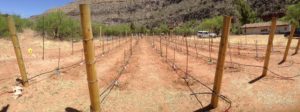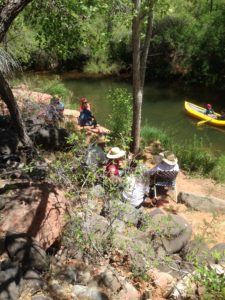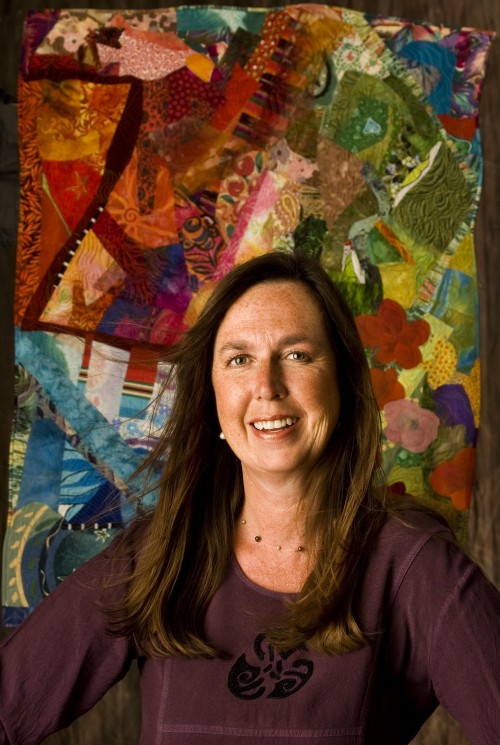 A little more than 10 years ago, Michael Wolcott was writing a weekly column for Flagstaff Live!, but he needed a break and floated an idea to Tony Norris:
A little more than 10 years ago, Michael Wolcott was writing a weekly column for Flagstaff Live!, but he needed a break and floated an idea to Tony Norris:
“I…would like to generate a column that uses each of our voices….Our voices are representative, I think, of a certain cast of characters who’ve chosen to live on this great ocean of sedimentary rock, the high dry plateau we think of as home. We have lived in communes and in tents, in high-rises and vehicles….We have worked on the river, waited tables, opened businesses and made art here. We have acquired academic degrees and families here, fallen in love and had our hearts broken. And had them healed.”
He and Tony pitched the idea of a rotating column to Ryan Heinsius, then editor of Flagstaff Live! Tony dubbed the new column, which debuted on May 8, 2008, Letter from Home. Jean Rukkila wrote the first column, titled “Sacred is as sacred does,” which you can find a link to in the online version of this column.
And so it began. Week after week, we propped each other up when we faltered, stepped in to cover for each other, broke in new editors and every so often we met at Uptown Pubhouse for a beer, a shot of Irish whiskey or (rarely) a club soda.
By mid-2009, a group of five writers had settled into regular rotation: Tony, plus Shonto Begay, Kate Watters, Jean Rukkila and me. In 2012, Kate decided to take some time off and Laura Kelly joined the circle. Shonto left the fold and Peter Friederici stepped in. Tony dropped out, I stopped writing regularly and Margaret Erhart joined us. Of the original five, only Jean remains a regular. Weeks became months became years.
Today, more than 450 columns are archived on our website. As Maira Kalman would say, “How extraordinary!” It’s nothing I could have done on my own, so I’m impressed with the volume and the quality of this collection.
As someone who often works alone these days, the process of making something bigger than oneself intrigues me. I admire the way recalcitrant teachers used the #RedForEd movement to force a balky legislature to increase funding for education in our state, for example. By their numbers and a stalwart effort, they achieved success where other, more long-term and studiously calculated efforts failed.
I recently witnessed firsthand a barn raising of sorts as a crew of 12 of us planted 126 vines on our friends’ property in the Verde Valley area.
Alan, who has had this dream for many years, took a viticulture course at Yavapai College a few years ago. In 2017 he found the perfect spot to fulfill his vision. He and Roberta bought the property and began planning. Starting last fall, he built a well house and installed irrigation. In the spring, with a bit of help, he erected a fence against critters, put in posts for the vines and strung trellis wire. He ordered vines and put out the call to friends for a planting party.
When the volunteers showed up on Sunday morning, they literally dug in. Alan showed us how and where to dig the holes, how to trim the vines and instructed us to sprinkle some kind of magic powder on the roots.
“Mound some dirt into the bottom of the hole, then put the vine in the hole up to about here,” he said, indicating a fist-length below the graft. “Back fill the hole, then make a well around the vine. Sprinkle some of this around it, and then mulch.” He’d planned out all the steps and could easily explain the process. He was able to step back, answer questions and play the benevolent overseer.
One thing I’ve noticed about river people: they are pros at using teamwork to get things done. They are accustomed to planning and communally executing big projects, to setting up encampments day after day, and to using the power and knowledge of the group to rescue a flipped dory, treat injuries or worse. Alan and Roberta have a long history with the river community and a lot of the people who showed up either work on the river now or once did. While only one of us had ever planted a vineyard before, we all just went to work. Thanks to Alan’s planning and everyone pitching in, all the work was done in about two and a half hours.
 On that blessed day we toasted our effort and our visionary leader with water; Alan handed out official 2018 Grapevine Planting Certificates, entitling us to a bottle of the first release wine. We are all invested in his vision now.
On that blessed day we toasted our effort and our visionary leader with water; Alan handed out official 2018 Grapevine Planting Certificates, entitling us to a bottle of the first release wine. We are all invested in his vision now.
Imagination is a critical component of these projects; someone has to be the dreamer. It takes Vision with a capital V to imagine such an enterprise, and a unique set of skills to bring the whole project to fruition.
One of my favorite visionaries is artist Liza Lou, who dreams up and coordinates the making of room-size (and sometimes larger) installations with help from a host of artisans and volunteers. One of her early works is a 500 square-foot backyard scene complete with blades of grass, a picnic table, a lawn mower, flowers, insects, leaves and a clothesline, all meticulously rendered in tiny glass seed beads.
I recently delved into the making of Ai Weiwei’s Sunflowers artwork, in which he filled the Tate Modern’s Turbine Hall in London with 100 million porcelain sunflower seeds. The gallery is about 10,000 square feet and was filled to ten inches deep with the things. A short film documents the Herculean process: the years it took 1,600 workers in a small Chinese town to make the realistic-looking seeds and the enormous logistical challenge required to transport and install the piece. Weiwei had a vision and there was no chance that he could have completed that project in his lifetime without help.
And so it goes with the Letter from Home column. As of this week, at FlagstaffLetterfromHome.com there are 454 essays (almost a complete archive) on an unimaginable variety of topics. I calculate that we’re close to 500,000 words, plus a collection of 230 drawings, snapshots, paintings and stock photographs.
That’s a start.

